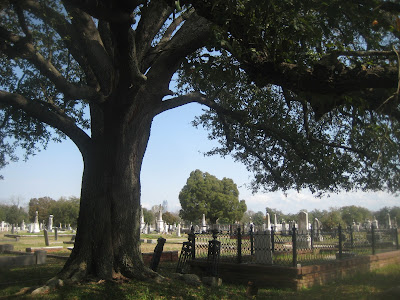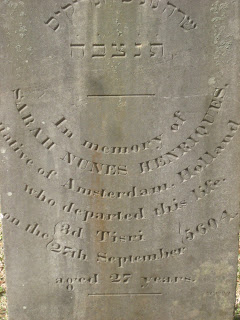A century's old Live oak tree growing out of a Antebellum family plot. There is a Old Southern Wise Tale that slaves placed acorns in coffins of masters they did not like so that the grave could be destroyed by a oak tree that would grow out.
This is the first part of a five part series. The 19th century architecture of Magnolia Cemetery is amazing some of the styles represented here are Federal, Classical, Neoclassical, Neo-Renaissance , Greek Revival, Rococo Revival, Egyptian Revival and Second Empire. I grew up around Magnolia Cemetery and live down the street from it now and have a plot there. Although I'm not looking forward to being interred there, you will see why a couple photo's down. When it rains in Mobile this cemetery becomes a swamp! I have walked thru this lovely cemetery since I was age 9 and walk thru it a few times a week. I often take my dog Belle who I have had for 15 years. She loves sniffing around the Antebellum marble Tombs. This cemetery is mostly the resting place of 19th century Mobile's WASP community better known as White Anglo-Saxon Protestant. During Mobile's Golden period 1820-1860 many East Coasters Moved here in search of there fortune thru Slavery and the white gold of cotton. When looking at tombs in this cemetery most list the place of birth with many being from New York and Virginia. But the cemetery also has graves of Free-people-of-color, slaves, Jews, Creoles and European Settlers to Mobile. Please click on photo's to read the inscriptions.
Magnolia Cemetery was established in 1836 and is situated on 120 acres. From 1836 onward it served as Mobile's primary burial site during the 19th century. Magnolia contains more than 90,000 burials and remains an active, though very limited, burial site today. In the 18th century Mobile was a Creole city with French and later Spanish immigrants. Protestant English and American settlers began arriving early in the 19th century and Church Street Cemetery was established by the City of Mobile in 1820. Within a decade it became apparent that more land would be needed for burials. Like many coastal cities, Mobile was visited with yellow fever epidemics which killed thousands of men, women and children.
There had been a national trend to establish cemeteries away from crowded urban centers and the creation of Magnolia Cemetery in 1836 followed that trend. Its original 30 acre tract was outside the city limits but could be reached by carriage and later streetcars. In 1846 the city began to grant free burial plots within the cemetery to civic, labor, and religious organizations. The Coal Handlers Union, Colored Benevolent Institution Number One, Cotton Weighers Society, Draymens Relief Society, Homeless Seamen, Independent Ladies Mill and Timber Association, and the Protestant Orphan Asylum Society were among those organizations to take advantage of this policy. Members who might not have the money for a plot could be assured of a space with their membership dues until it was ended in 1873.
Although Magnolia Cemetery was city owned, no records of who was buried there were maintained by city employees until 1912. Prior to that it was up to the lot owner to know who was buried where since many graves were never marked. The cemetery grew in size over the years and now encompasses more than 100 acres. Some 100,000 are buried in Magnolia Cemetery although less than 90,000 are known since many rest in older unmarked graves.
By 1970 nearly 60% of the cemetery was abandoned and it had become extremely overgrown. In 1984 the Historic Mobile Preservation Society formed the Friends of Magnolia Cemetery as a non-profit corporation. The goals of the new organization included the establishment of perpetual care for the plots, cleaning up the cemetery and improving the existing plantings, improving maintenance, restoring historic monuments and ironwork, hiring of a superintendent for day to day operations, and surrounding the site with a contemporary iron fence conceived and designed by local architects Arch Winter and Thomas Karwinski. The efforts by the Friends of Magnolia Cemetery led to the cemetery being placed on the National Register of Historic Places in 1986.
The flowing headstone are of Jewish Mobilian's located in the Jewish Rest section, also known as the Old Hebrew Burial Ground, was deeded to Congregation Sha'arai Shomayim or Gates of Heaven, the oldest Reform Jewish congregation in the state of Alabama, by the City of Mobile on 22 June 1841. Jewish Rest is the oldest Jewish burial ground in Alabama. The Jewish Rest section was full after only a few decades and led to the establishment of two additional Jewish cemeteries in Mobile, the Sha'arai Shomayim Cemetery and the Ahavas Chesed Cemetery for the Conservative Jewish congregation.
The part of the Jewish Cemetery contains many simple styles with Hebrew inscriptions
Pitcher on a Jewish grave, it symbolizes a Levite, a person who was responsible for cleaning the hands of the Temple Priest.
Pitcher on a Jewish grave, it symbolizes a Levite, a person who was responsible for cleaning the hands of the Temple Priest. The part of the Jewish Cemetery contains many simple styles with Hebrew inscriptions
My baby Belle in between 19th century cast iron
A sleeping child is a Victorian symbol for death.
A Greek Revival marble Tomb on Quincy granite base Note the upside down torch represents the end of life snuffed out
A mid 19th century cast iron classically draped lady
From the Island of Martinique
Born in St Pierre, Martinique
A draped or broken column represents the break in earthly to heavenly life
Greek Revival Cast Irin "Rest in Peace"
A child's aboveground tomb made of costly imported East Coast red brick
Born in Sheffield England
A draped or broken column represents the break in earthly to heavenly life
Died aged 1 year and 5 months
Click on photo to see water in this tomb
A Gothic Revival cast iron fence around a family plot
Clasped Hands~Farewell to earthly existence. Also unity. Often used as a Masonic and I.O.O.F. symbol.
Died 1839 aged 18 years
Born in Long Island, NY in 1780
A pair of obelisks from the Ketchum family
Our darling Kenneth the only son of Thomas E. and Sarah M Massey died 1853 aged 3 years and 7 months
Lambs are often seen on children's gravestones. A lamb represents innocence.
A Rococo Revival cast iron fence around a family plot
A Rococo & Gothic Revival cast iron fence around a family plot
A Rococo & Gothic Revival cast iron fence around a family plot
A cast iron fence around a family plot
This Tomb stone is in French
Husband and wife born in Germany and Switzerland
Clasped Hands~Farewell to earthly existence. Also unity. Often used as a Masonic and I.O.O.F. symbol.
Wreath Victory in death
This Style of Tomb is rare and is called a Table Tomb
Rococo Revival marble Tomb stone erected to the memory of Ellenora daughter and wife died aged 18 in 1861
Rococo Revival marble Tomb stone erected to the memory of Ellenora daughter and wife died aged 18 in 1861
Rococo Revival marble Tomb stone erected to the memory of Ellenora daughter and wife died aged 18 in 1861
Wreath Victory in death
This Style of Tomb is rare and is called a Table Tomb
A draped or broken column represents the break in earthly to heavenly life
A draped or broken column represents the break in earthly to heavenly life
Clasped Hands~Farewell to earthly existence. Also unity. Often used as a Masonic and I.O.O.F. symbol.
Pennsylvania Blue King of Prussia Marble base
Clasped Hands~Farewell to earthly existence. Also unity. Often used as a Masonic and I.O.O.F. symbol.
A interesting brick stucco obelisk
Belle by the interesting brick stucco obelisk
Note the upside down torch represents the end of life snuffed out













































































We have a Magnolia Cemetery in Charleston as well and it's pretty amazing... I've been planning on doing a post on it for a while. There's an Egyptian pyramid mausoleum... very interesting- thanks you sharing!
ReplyDeletewww.jwcsybaritic.blogspot.com
So hauntingly beautiful old Cemetaries. This one has some magnificent headstones. Alas, here in the Southwest most of the cemetaries no longer have raised headstones, so almost all of them now are just plain slabs flat on the ground so they can easily mow the lawn over them. I remember in Europe I loved to see the beautiful ancient cemetaries... during the day of coarse... *winks*
ReplyDeleteDawn... The Bohemian
What a beautiful place whith all kinds of history and and beautiful cast iron. Thank you for the tour and I luv your pup belle she is a cutie. Have a good day..........Julian
ReplyDeleteI just love cemeteries. Thanks for posting this one. Love your baby. Richard
ReplyDeleteThis post took me back to special moments in my teenage years where I was known as the "cemetery babysitter"...it was a good thing in West Seattle to go to Forest Lawn sit by the fish pond, walk among the velvet green grass and look at the big sky in wonder. Lucky for me...you invoked a delight in my soul!
ReplyDeleteI really like your title but I think this is much nicer than Père Lachaise. More space, less ornament. I do love old cemeteries, the older the better, so I've really enjoyed this post. :-)
ReplyDeleteThe grave in French is actually that of a Swiss person who died at just over 20...
Re. the recumbent statues on VDP: yes, they are in the palace but the 'real' tombs of the duke and duchess are in Bruges, Belgium, which at the time belonged to... Burgundy.
Oh... and bonjour Belle !
Sorry... archduchess!
ReplyDeleteHi JWC I will be looking forward to your Magnolia Cemetery in Charleston post! @ Bohemian I love beautiful old Cemeteries in Europe and America! I have been locked in two cemetery's in my life time as the sun was going down and had to climb 20 foot high fence to get out! You are welcome Julian . Thanks Richard I love Belle so much! Mrs. Wright I was the same as you at that age! Hi cieldequimper is there a old cemetery in the village of Versailles? I would like to visit the next time I'm in France. Thanks for the info. Belle says bonjour back as she knows French and English!!!
ReplyDeleteHello Andrew. If you click on the 'graveyard' label on the bottom left of VDP, you'll find some cemetery photos.
ReplyDelete